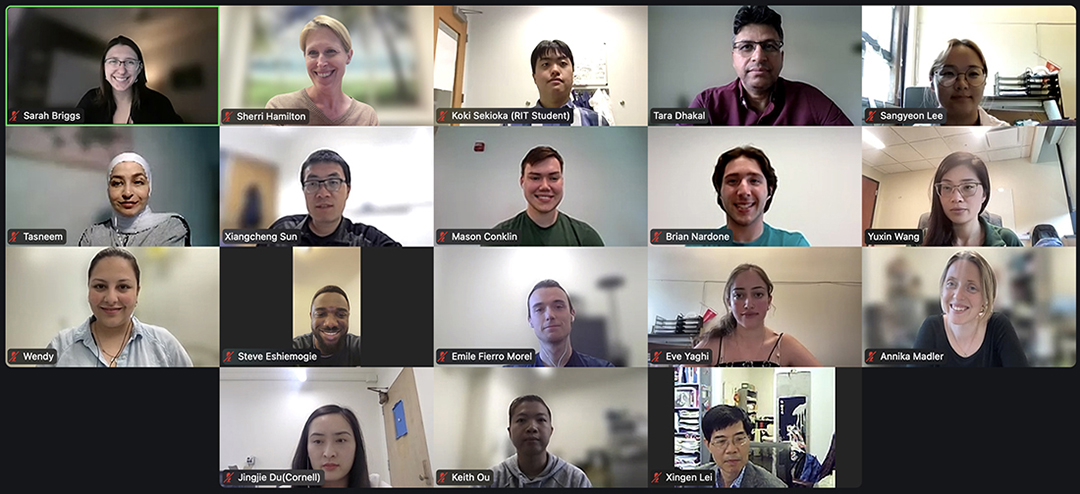Students challenged to phase out toxic chemicals using green chemistry
NYSP2I symposium, "Reagents of Change," will take place Sept. 20 in Troy, New York.
Monthly check-in meetings allow the student research teams to collaborate remotely and share findings throughout the summer.
What you need to know:
- NYSP2I’s annual summer-long research program gives students across its five partner universities—including Binghamton University, Clarkson University, Cornell University, Rensselaer Polytechnic Institute (RPI), and Rochester Institute of Technology (RIT)—in New York State the opportunity to lead research to solve real-world sustainability problems.
- The annual program’s second year once again asks student-led teams to tackle a difficult, real-world sustainability challenge. This year, the students are tasked with developing alternatives to the use of toxic chemicals in consumer products or industrial processes by applying principles of green chemistry. Their goal is to achieve “benign” chemical design, which means minimizing the use of hazardous chemical reagents and identifying safer alternatives.
- The 2024 challenge includes four teams featuring undergraduate and graduate students and research faculty members from Binghamton University, Cornell University, RPI, and RIT.
- The RIT team aims to "upcycle" post-consumer polyolefin plastic into metal sensors that can be used to monitor lead pollution in water resources.
- This year’s teams will present their findings at a research symposium on September 20, 2024, at Rensselaer Polytechnic Institute in Troy, New York, that is free and open to the public.
This summer, four teams of students from Rochester Institute of Technology (RIT) and three other universities across New York State are leading research focused on green chemistry to discover more sustainable chemical products or processes. The teams are participating in an annual program launched by the New York State Pollution Prevention Institute (NYSP2I). The results of their work will be presented at a research symposium hosted by NYSP2I at Rensselaer Polytechnic Institute in Troy, New York, on September 20, 2024, featuring a keynote address by John Warner, co-founder of green chemistry.
Second annual summer-long challenge
“Reagents of Change” is the second challenge of the annual Student and Faculty Research Program, which takes place over the summer each year. The initiative was created by NYSP2I to foster the creative thinking, problem-solving, and collaboration that is fundamental to sustainability. By engaging university students in this way, the program supports the institute’s wider efforts to solve complex sustainability problems for a brighter future for New York.
Teams of students, each led by a faculty principal investigator (PI), enrolled in NYSP2I’s five partner universities—Binghamton University, Clarkson University, Cornell University, Rensselaer Polytechnic Institute (RPI), and Rochester Institute of Technology (RIT)—are eligible to participate in the program by proposing a research project.
Each summer-long project immerses undergraduate students in the academic research environment, where they collaborate with faculty members and graduate students. Together, teams develop a research project concept, propose it to NYSP2I, and, if it is accepted, conduct original research. Importantly, students have the chance to present their findings at an academic symposium held at the end of the program each year.
“Reagents of Change: Green Chemistry and Safer Chemicals in Products and Industry”
NYSP2I’s 2024 program has tasked four student-led teams with developing alternatives to the use of toxic chemicals in consumer products or industrial processes by applying principles of green chemistry. Their goal is to achieve “benign” chemical design, which means minimizing the use of hazardous chemical reagents and identifying safer alternatives.
What is green chemistry?
Chemicals are ubiquitous in our everyday lives, whether they are in the products we use, the food we eat, the water we drink, or even the air we breathe. Historically, chemists have not considered the health and environmental profiles of new chemicals, which has led to a variety of toxic and often environmentally damaging chemicals entering the market. Green chemistry seeks to change the historical legacy of toxic chemicals by guiding the design of safe and sustainable chemical processes and products that do not contain hazardous chemicals. The 12 principles of green chemistry can be applied to achieve the goal of benign chemical design, but also focus on minimizing waste formation and the use of hazardous chemical reagents, while striving for safer alternative chemicals and processes to minimize the negative impacts of chemicals.
Project scope
The teams were asked to propose research projects that address a range of topics, all guided by the principles of green chemistry to reduce the use of hazardous chemicals in consumer products or industrial processes. Work could include research around emerging contaminants such as PFAS (per- and polyfluoroalkyl substances) and 1,4-dioxane; chemicals of concern in industry such as lead, mercury, toluene, bisphenols, phthalates, and others; and compostable plastics and plastic alternatives. Teams were encouraged to consider aspects of innovation and creativity within their proposed research, both key components of green chemistry.
Four research projects by students are now underway.
A look at the 2024 student-led projects
Binghamton University
“Low-lead perovskite solar technology for a clean, green, and sustainable energy future”
Topic areas addressed:
- Chemical of concern: Lead
- Applies Green Chemistry Principle 4: Designing safer chemicals
- Applies Green Chemistry Principle 6: Design for energy efficiency
The Binghamton University team seeks to support renewable energy development in New York State by developing low-lead perovskite solar cells. Using the green chemistry principles of designing safer chemicals and designing for energy efficiency, the team will develop low-lead perovskite solar cells that will help to significantly cut greenhouse gas emissions during manufacturing, deployment, and operation of perovskite solar technology. Perovskite solar cells have approximately 10 times less lead than traditional silicon solar technology, which uses lead in its metal contacts. The team also seeks to further reduce the lead content in perovskite solar cells by at least 50 percent, and to conduct environmental toxicity studies via degradation testing to assess chemical leaching, thereby reducing the toxic metal use in solar-energy production.
Faculty principal investigator (PI) co-advisors:
- Yuxin Wang, Assistant Professor, Systems Science and Industrial Engineering
- Tara Dhakal, Associate Professor, Electrical and Computer Engineering; Director, Center for Autonomous Solar Power
Student participants (lead listed first):
- Tasneem Tawalbeh, Systems Science and Industrial Engineering (Graduate)
- Wendy Reyes Ramos, Materials Science and Engineering (Graduate)
Cornell University
“Developing a novel tri-enzyme complex as a new poultry feed additive to enable simultaneous decreases of manure nitrogen, phosphorus, and heavy-metal pollutions”
Topic areas addressed:
- Chemicals of concern: Nitrogen, phosphorous, and heavy metals
- Applies Green Chemistry Principle 1: Waste prevention
The Cornell University team aims to apply the first principle of green chemistry—waste prevention—to prevent excess nutrient pollution from New York State poultry operations by developing a feed-additive to reduce the amount of nitrogen, phosphorous, and heavy metals in chicken manure. The team will develop a novel tri-enzyme complex containing protease, encapsulated phytase, and encapsulated laccase that aims to reduce nitrogen, phosphorous, and heavy metals excreted from poultry diets. By preventing excess nutrients from entering the environment, this project will help prevent freshwater eutrophication caused by waste runoff.
Faculty PI advisor:
- Xingen Lei, Professor, Animal Science; Associate Dean, Office of Research and Innovation
Student participants (lead listed first):
- Emile Fierro Morel, Animal Science (Graduate)
- Annika Madler, Food Science and Technology (Graduate)
- Keith Ou, Animal Science (Graduate)
- Jingjie Du, Nutritional Science (Graduate)
Rensselaer Polytechnic Institute
“Economical biopolymer production through waste CO2 upcycling”
Topic areas addressed:
- Chemicals of concern: Carbon dioxide and plastics
- Applies Green Chemistry Principle 7: Use of renewable feedstocks
- Applies Green Chemistry Principle 9: Catalysis
- Applies Green Chemistry Principle 10: Design for degradation
The RPI team seeks to address global warming and plastic pollution by directly converting industrial waste carbon dioxide (CO2) to lactic acid. By applying multiple principles of green chemistry, the team will demonstrate a more economical route for the production of polylactic acid (PLA), an important biopolymer, through direct conversion from waste CO2 gas using an earth-abundant iron electrocatalyst. Additionally, by creating a biodegradable polymer from renewable feedstocks, this project will demonstrate material circularity.
Faculty PI advisor:
- Vidhya Chakrapani, Associate Professor, Chemical and Biological Engineering
Student participants (lead listed first):
- Eve Love Yaghi, Chemical Engineering (Undergraduate)
- Sangyeon Lee, Chemical Engineering (Graduate)
- Steve Eshiemogie, Chemical Engineering (Graduate)
RIT
“Upcycling of polyolefin plastics to fluorescent materials for detection of metal ions”
Topic areas addressed:
- Chemical of concern: Lead
- Applies Green Chemistry Principle 2: Atom economy
- Applies Green Chemistry Principle 11: Real-time pollution prevention
The RIT team aims to upcycle polyolefin plastic waste into fluorescent carbon dot Pb2+ metal sensors for monitoring lead pollution in environmental and industrial water sources. By valorizing plastic waste into value-added materials, this project will help decrease the amount of plastic waste incinerated or landfilled. The team will develop fluorescent carbon dots from polyolefin plastics and then develop chemical sensors with high sensitivity and selectivity for lead ions. The project will apply the green principle of atom economy by utilizing plastic wastes as the carbon source for carbon dots, and the chemical sensors will be a portable and low-cost application for real-time pollution prevention.
Faculty PI advisor:
- Xiangcheng Sun, Assistant Professor, Chemical Engineering
Student participants (lead listed first):
- Koki Sekioka, Chemical Engineering (Graduate)
- Brian Nardone, Chemical Engineering (Undergraduate)
- Mason Conklin, Chemical Engineering (Undergraduate)
Event details
The 2024 research symposium
- What: “Reagents of Change: Green Chemistry and Safer Chemicals in Products & Industry,” the 2024 NYSP2I Student and Faculty Research Program Symposium
- Where: Rensselaer Polytechnic Institute, Troy, New York
- When: Friday, September 20, 2024













